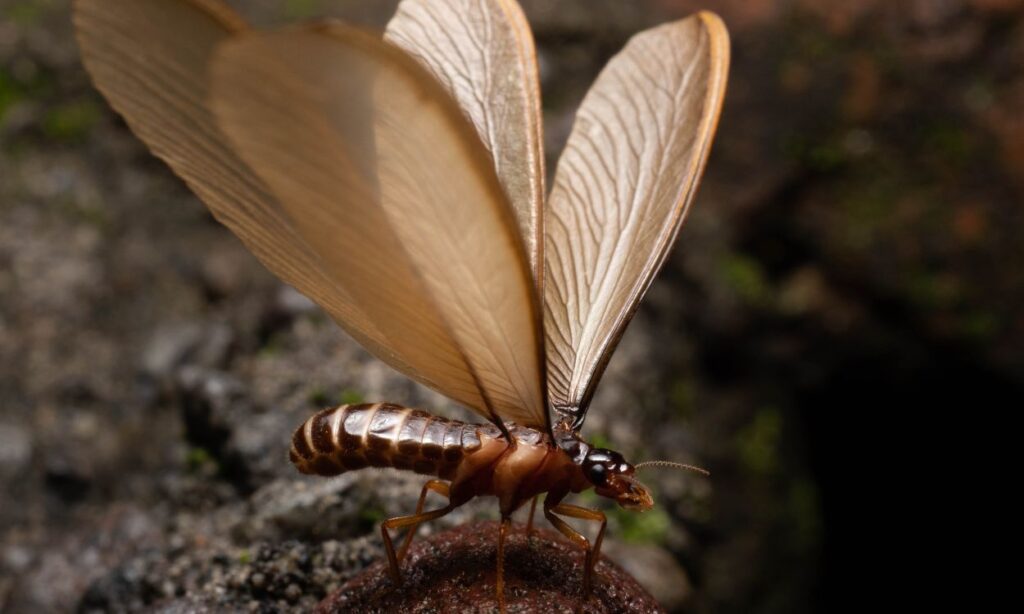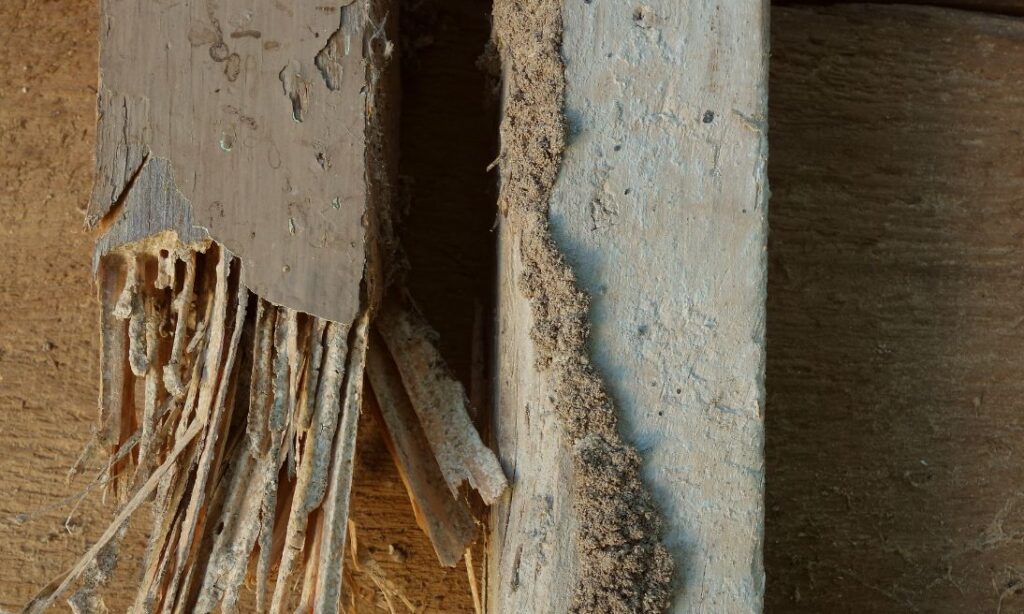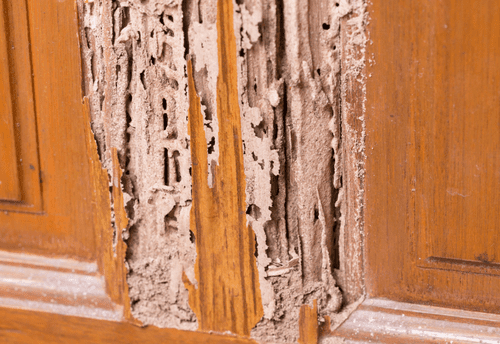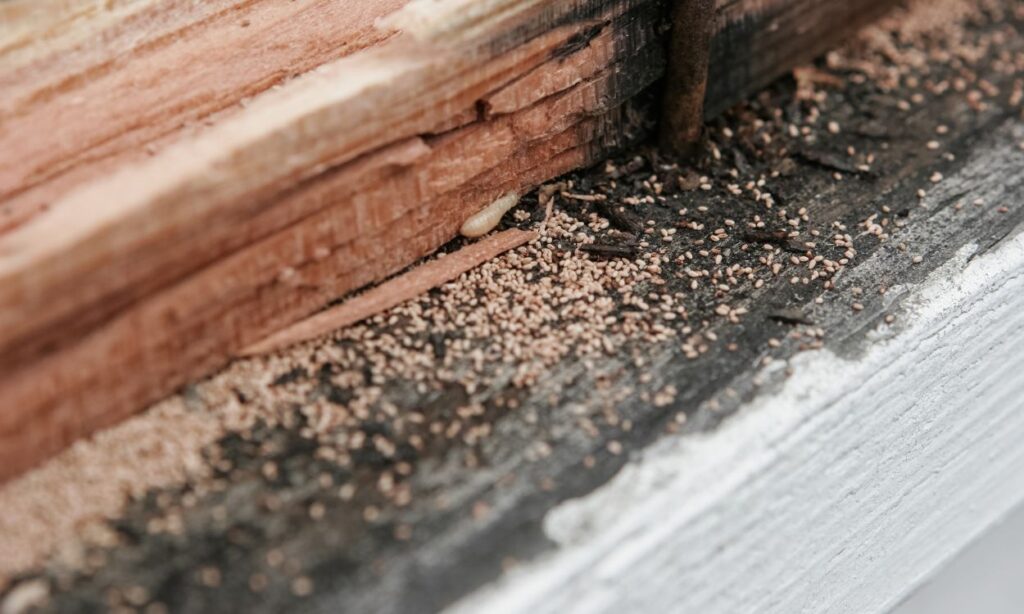Termites cause Billions of dollars in damage yearly in the US, highlighting the need for homeowners to understand how to prevent termite infestations effectively. Often called the “silent destroyers,” termites can cause significant damage, often without any visible signs until it’s too late. In this article, we show essential strategies and insights on how to prevent termite infestations, equipping you with the knowledge to protect your property from these pests.

Understanding the Enemy
First things first, we must know our enemy so we can understand how to prevent termite infestations effectively. Termites are often confused with ants because of their social organization and colony living, termites have unique characteristics that set them apart. Recognizing these differences is key to targeted prevention and control strategies.
Social Structure and Roles Within the Colony
Termites show an organized social structure, with each member playing a specific role essential for the colony’s survival. These roles include:
- Workers: The backbone of the colony, responsible for foraging, feeding other members, and maintaining and expanding the nest.
- Soldiers: Tasked with defending the colony from predators and threats, characterized by their larger mandibles and often more robust bodies.
- Nymphs: Immature termites that will eventually mature into one of the specialized castes within the colony. In some colonies, they fulfill the role of the worker cast until they outgrow their nymph stage.
- Swarmers (Alates): The reproductive winged termites, responsible for leaving the colony to mate and establish new colonies. The appearance of swarmers is often the most visible sign of a termite infestation to homeowners.
- Reproductive Individuals (Queen and King): The founders of the colony, with the queen playing a vital role in laying eggs to ensure the colony’s growth and survival.

Swarming Termites
Swarming is a critical phase in the termite life cycle, particularly for species that pose a threat to buildings and wooden structures.
- WHAT IS SWARMING?
- Swarming is when the Swarmers or Alates emerge from the colony and fly away to establish new colonies.
- Swarming is when the Swarmers or Alates emerge from the colony and fly away to establish new colonies.
- WHY DO TERMITES SWARM?
- Termites swarm to reproduce and expand their colonies, typically occurring in warm and humid conditions, signaling the presence of mature colonies nearby and the potential for new infestations.

Types of Termites
There are over 2,000 species of termites in the world and although they may share similar characteristics like swarming, colony structure, and roles they can have very different lifestyles. Termites are gathered into 3 categories: Subterranean, Drywood, and Dampwood. Understanding these 3 categories gives us better knowledge of how to prevent termite infestations:
Subterranean Termites
Subterranean termites are the most commonly encountered type by homeowners across the United States, present in every state except Alaska. They are responsible for approximately 95% of the termite damage reported annually in the country. Exploring the characteristics of these termites reveals why they are such a significant threat, causing extensive damage each year:
Lifestyle and Adaptations:
- Moisture Requirement: Thrive in moist environments, utilizing soil moisture for survival.
- Mud Tubes: Construct pencil-sized mud tubes from soil, wood particles, and their saliva and feces for protected above-ground access to food.
- Critical for Survival: Mud tubes provide a vital, moist, and shielded path between their underground colonies and food sources.
Colony Size and Social Structure:
- Large Colonies: Can number in the millions, contributing to their extensive damage potential.
- Swarming Behavior: Typically swarm on warm spring and summer days, often following rainfall, to establish new colonies.
Understanding the most common type of termite in the United States helps us understand how to prevent termite infestations. If you are seeing signs of these termites seek professional help promptly to prevent any further damage to your home. Although these are the dominant termite species in the United States, you may encounter other termites as well.
Drywood Termites
Drywood termites, as their name suggests, infest drywood and they don’t need secondary contact with the soil. They can live solely in the wood that they consume. This makes it difficult to come across any signs of these termites until it is too late. Taking a closer look at drywood termites will help us understand how to prevent termite infestations:
Lifestyle and Adaptations:
- Wood as Habitat: Inhabit and consume the wood they live in, allowing them to infest furniture, floors, and framing.
- Moisture Extraction: Obtain necessary water directly from the wood, enabling survival in dry conditions.
- Warm Climate Preference: Predominantly found in warm, coastal, southern, and southwestern U.S. regions, like California, Arizona, Florida, and Texas.
- Dry Wood Preference: Favor dry wood for habitation, posing risks in areas with lower humidity.
Colony Size and Social Structure:
- Smaller Colonies: Form colonies with up to 2,500 members, smaller than subterranean termites.
- Swarming: Swarm on sunny, warm days, typically following a temperature rise, to establish new colonies.
- Immature Termites: Perform tasks typically done by workers, such as foraging, nest maintenance, and caring for eggs, until they mature.
These Termites can be very damaging to your property considering they can live in the wood they consume. If you suspect you have an infestation from Drywood termites seek professional help from a company that knows how to prevent termite infestations as well as remove them.
Dampwood Termites
Dampwood termites are typically found in wood with high moisture content. These termites are less common in residential structures unless there are areas with excessive moisture problems. However, knowing how to prevent termite infestations involves a basic understanding of all three categories of termites.
Lifestyle and Adaptations:
- Moist Wood Preference: Favor decaying or moisture-rich wood, often from water leaks, poor drainage, or soil contact.
- No Soil Contact Needed: Unlike subterranean termites, dampwood termites can thrive without direct contact with soil.
- Less Visible Damage: Damage is often contained within wood and less apparent, as they don’t create mud tubes.
- Swarming Habits: Swarm in late summer, usually on warm, humid evenings, indicative of their reproductive cycle.
Colony Size and Social Structure:
- Smaller Colonies: Form smaller colonies than drywood termites, with populations ranging from a few hundred to a thousand.
- Late Summer Swarming: Swarms occur post-rainy season, reflecting their preference for humid conditions.
Understanding the differences between subterranean, drywood, and dampwood termites is crucial for implementing the right prevention strategies. Now that we know a little bit more about our enemy we can learn how to prevent termite infestations.
How to Prevent Termite Infestations
Understanding what termites are more dominant in your area is a great start when learning how to prevent termite infestations. This way you can determine what preventative measures to spend a little extra time on. Following all these steps around your home is how to prevent termite infestations:
Universal Termite Prevention Strategies
These foundational steps are effective in deterring most termite species:
- Moisture Control: Fix leaks, ensure good drainage, and enhance ventilation to reduce humidity and moisture, making your home less attractive to termites.
- Wood Management: Keep wood, including firewood and lumber, away from your home’s foundation. Avoid wood-to-ground contact by elevating structures where possible.
- Seal Entry Points: Fill in cracks and crevices in your home’s foundation, walls, and around utility lines to block entry paths for termites.
- Regular Inspections: Conduct annual professional inspections and regular personal checks for signs of termite activity.
- Landscaping Care: Trim vegetation away from your home and use cellulose-free mulch to reduce termite access and attraction.
Subterranean Termite-Specific Strategies
For the most widespread termite type in the U.S., consider these additional measures:
- Mud Tube Removal: Regularly inspect for and destroy subterranean termite mud tubes found on or near your home’s foundation.
- Physical Barriers: Install barriers like basaltic particle barriers or stainless steel mesh around your home’s foundation to deter tunneling.
Drywood Termite-Specific Strategies
Drywood termites require different tactics due to their unique habits:
- Ventilation and Dehumidification: Especially in attics and crawl spaces to make these areas less hospitable for drywood termites.
- Wood Treatment: Apply surface treatments or injectable treatments to exposed wood to kill and prevent drywood termite infestations.
Dampwood Termite-Specific Strategies
Given their preference for moist wood, focus on:
- Eliminating Water Sources: Repair external water leaks, improve soil drainage, and ensure gutters direct water away from the home to reduce wood moisture content.
- Wood Replacement: Replace decayed or water-damaged wood, as it’s a prime target for dampwood termites.
With this comprehensive guide on how to prevent termite infestations, you’re prepared to get your home safer against the threat of termites. Whether facing subterranean, drywood, or dampwood termites, each step you take is crucial in building a strong defense. Consistently applying these strategies and staying aware of signs of termites are essential in ensuring your efforts to prevent termite infestations are successful. If an infestation is suspected, remember that prompt action and seeking professional advice are key to keeping your home protected and termite-free.
Signs of a Termite Infestation
Knowing how to prevent termite infestations is important but knowing when you have an active infestation is even more crucial. Recognizing the early signs of termite activity will give you an advantage in timely removal. Here’s what to look out for, categorized by termite type:
Subterranean Termites:
- Mud Tubes: Look for pencil-sized mud tubes along foundation walls, which subterranean termites use to travel between their soil colonies and food sources.
- Swarmers: Seeing swarms of winged termites or discarded wings near your property can indicate a nearby subterranean termite colony.
- Damaged Wood: Wood that sounds hollow when tapped or appears crushed at structural bearing points may be infested by subterranean termites.

Drywood Termites:
- Frass: Drywood termites produce wood-colored droppings that resemble fine sawdust, often found near infested wood.
- Visible Tunnels in Wood: Drywood termite infestations can be identified by clean, smooth tunnels within wooden structures or furniture.
- Swarmers: The presence of drywood termite swarmers indoors often indicates an established colony within the structure.

Dampwood Termites:
- Moist or Decayed Wood: Dampwood termites are typically found in wood with high moisture content, often resulting from water leaks or poor drainage.
- Less Obvious Damage: Unlike other termites, dampwood termites do not produce mud tubes or frass, making their infestations harder to detect visually.
- Swarmers: Similar to other termites, the presence of dampwood termite swarmers in late summer, especially after rainy periods, can signal an infestation.

Understanding how to prevent termite infestations involves familiarizing yourself with termite behaviors, identifying different termite species, implementing effective prevention techniques, and recognizing the value of professional expertise. With their destructive nature and the challenge of eliminating them, it’s recommended to hire a reputable termite control service at the first sign of an infestation. In the long run, investing in professional termite management can save you time and money by preventing extensive damage to your property.
Got Termite Problems?
AIMVO Pest Control is a Licensed Company with Professional Ready To Help You Now.
Call and Get a Free Quote Today
